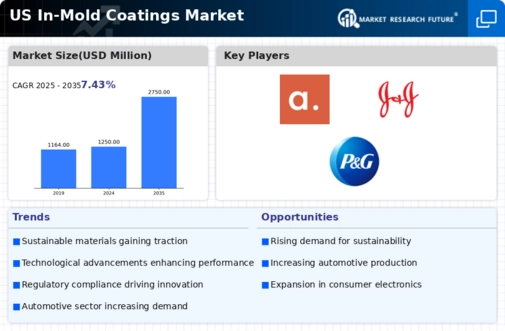The in mold coatings market is characterized by a dynamic competitive landscape, driven by innovation, sustainability, and strategic partnerships. Key players such as BASF SE (Germany), PPG Industries Inc (US), and Sherwin-Williams Company (US) are actively shaping the market through their distinct operational focuses. BASF SE (Germany) emphasizes innovation in product development, particularly in eco-friendly formulations, which aligns with the growing demand for sustainable solutions. PPG Industries Inc (US) has adopted a strategy of regional expansion, enhancing its manufacturing capabilities to better serve local markets. Meanwhile, Sherwin-Williams Company (US) is focusing on digital transformation, leveraging technology to optimize customer engagement and streamline operations. Collectively, these strategies contribute to a competitive environment that prioritizes sustainability and technological advancement.
The business tactics employed by these companies include localizing manufacturing and optimizing supply chains to enhance efficiency and responsiveness. The market structure appears moderately fragmented, with several key players exerting influence while also allowing for niche competitors to thrive. This fragmentation fosters a competitive atmosphere where innovation and customer-centric approaches are paramount.
In November 2025, PPG Industries Inc (US) announced the launch of a new line of bio-based in mold coatings, which are designed to reduce environmental impact while maintaining high performance. This strategic move not only positions PPG as a leader in sustainable coatings but also responds to increasing regulatory pressures and consumer preferences for greener products. The introduction of these coatings is likely to enhance PPG's market share and strengthen its brand reputation.
In October 2025, Sherwin-Williams Company (US) unveiled a comprehensive digital platform aimed at improving customer interaction and streamlining the ordering process for in mold coatings. This initiative reflects a broader trend towards digitalization in the coatings industry, enabling Sherwin-Williams to enhance customer satisfaction and operational efficiency. The platform's launch is expected to provide a competitive edge by facilitating quicker response times and personalized service.
In September 2025, BASF SE (Germany) entered into a strategic partnership with a leading technology firm to develop AI-driven solutions for optimizing the production of in mold coatings. This collaboration is indicative of the increasing integration of advanced technologies within the industry, potentially leading to enhanced product quality and reduced production costs. The partnership underscores BASF's commitment to innovation and positions it favorably in a rapidly evolving market.
As of December 2025, current competitive trends in the in mold coatings market are heavily influenced by digitalization, sustainability, and the integration of AI technologies. Strategic alliances are becoming increasingly vital, as companies seek to leverage complementary strengths to enhance their market positions. Looking ahead, competitive differentiation is likely to evolve from traditional price-based competition towards a focus on innovation, technological advancements, and supply chain reliability. This shift suggests that companies that prioritize these areas will be better positioned to thrive in the future.














Leave a Comment